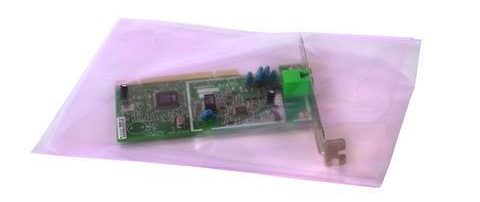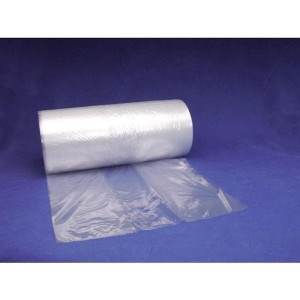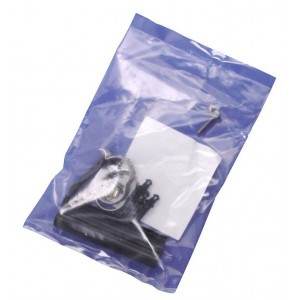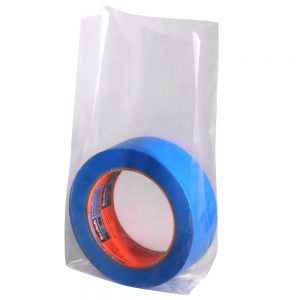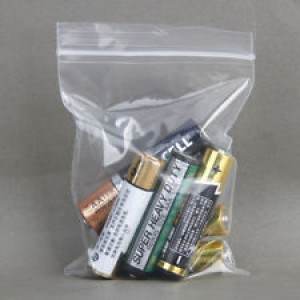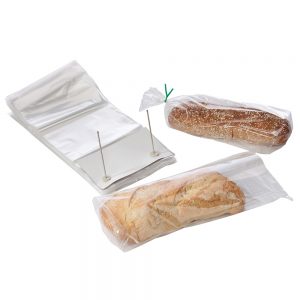
Anti-Block
Routinely added to film and bags to keep the sheets from sticking together.
Anti-Stat
Contains an anti-static additive that dissipates static electrical charges. Good for short-term storage. View Anti Static Poly Bags.
ASTM D6400 Certification
This specification covers plastics and products made from plastics that are designed to be composted in municipal and industrial aerobic composting facilities. The properties in this specification are those required to determine if plastics and products made from plastics will compost satisfactorily, including biodegrading at a rate comparable to known compostable materials. The purpose of this specification is to establish standards for identifying products and materials that will compost satisfactorily in commercial and municipal composting facilities.
ASTM D6868 Certification
This specification establishes the requirements for labeling of materials and products (including packaging), wherein a biodegradable plastic film or coating is attached (either through lamination or extrusion directly onto the paper) to compostable substrates and the entire product or package is designed to be composted in municipal and industrial aerobic composting facilities. This specification, however, does not describe the contents of the product or their performance with regards to compostability or biodegradability. In order to compost satisfactorily, the product must demonstrate each of the three characteristics as follows: (1) proper disintegration during composting; (2) adequate level of inherent biodegradation; and (3) no adverse impacts on the ability of composts to support plant growth.
Bagasse
A biodegradable and compostable material that is made from sugarcane fiber leftover after juice extraction. This fiber is made into disposable products normally made from plastic or virgin paper.
Bags on a Roll
Continuous roll of seamless tubing perforated under bottom seal. Bags must be torn off to open. View Flat Poly Bags on a Roll. View Gusseted Poly Bags on a roll.
Bag Signs
A bag sign is a plastic bag that is stretched over a wire frame. Typically, the wire frame is rectangular with an open end. The two wire rods on the open end are pressed into the ground and the bag sign is stretched over the wire frame to display the printing on either side of the bag. The bag signs made by Custom Poly are printed on LDPE film with a special backing to prevent sunlight conditions from interfering with the printed message on either side of the sign. Bag signs are most familiar during election years when candidates use them as part of their campaign efforts.
Barrier Film
Specially formulated film typically used to extend the shelf life of food products. Prevents transmission of moisture and gases.
Biodegradable
A material that is capable of undergoing decomposition into simple compounds such as carbon dioxide, methane, water, inorganic compounds and biomass. The predominant mechanism for decomposition is the enzymatic action of micro-organisms. There are no requirements regarding residues or time to breakdown.
BPI (Biodegradable Products Institute)
The U.S. standard in compostability. The BPI Logo Program is designed to certify and identify plastic products that will biodegrade and compost satisfactorily in actively managed compost facilities. The BPI and US Composting Council (USCC) use American Society for Testing and Materials Specifications (ASTM) to approve products for their “Compostable Logo” effort. These specifications are the result of 8 years of intensive work by researchers, product manufacturers, composters, and resin producers to identify plastic and paper products, which disintegrate and biodegrade completely and safely when composted in a municipal or commercial facility, like kraft paper, yard trimmings and food scraps. In order to be BPI certified, products must meet ASTM D6400 or D6868 standards based on testing in approved independent laboratories.
Bioplastics
Bioplastics, also called organic plastics, are a form of plastics derived from renewable biomass (living and recently dead biological material) sources, such as vegetable oil, cornstarch, or pea starch, rather than fossil fuel plastics which are derived from petroleum.
Black Conductive Film
An anti-static film made with a carbon black additive. A humidity-independent, corrosion-resistant, non-contaminating film with a long shelf life. View Black Conductive Poly bags.
Bleached White Kraft
Common paper bag. Bleaching is done by a chemical process.
Blown Film
The most common method of producing film and bags. Resin is melted in the extrusion process and blown vertically into a bubble to cool.
Bottom Gusset
A bottom gusset is formed by pushing the bottom, closed end of a flat poly bag up, into the bag interior making an accordion type fold or pleat at only the bottom of the bag. Bottom gusset bags are always sidewelded. The size of the bottom gusset is measured across the open or unfolded dimension. The bottoms of plastic bags constructed in this manner sit more or less flat on a surface when filled.
Bottom Seal Bags
Individually cut bags from seamless tubing, sealed on the bottom. Flat or side gusseted bags with a seal – usually have a tail.
"C" Cut Handle
A carrying handle die-cut into the top of the bag that leaves a flap of material in place
Cast Film
Extruded in sheet form through a slotted die.
CFC's
CFC's, or Chlorofluorocarbons, are a mixed group of chemical compounds composed of carbon, fluorine, chlorine and hydrogen alkenes. They are nontoxic and nonflammable and can be readily converted from a liquid to a gas and vice versa. Their commercial and industrial value notwithstanding, CFCs have been found to pose a threat to the environment through ozone depletion.
Clarity
Transparency of the film based upon surface gloss and haze.
Coated
Clay or other material coating on paper to make it smoother and less absorbent to ink. Produces a smooth finish and better print, but can rub off and crack on folds taking the ink with it.
Compostable
Capable of undergoing biological decomposition in a compost site as part of an available program, such that the material is not visually distinguishable from other compost and breaks down into carbon dioxide, water, inorganic compounds, and biomass, at a rate consistent with known compostable materials (usually 90 days). These compostable materials leave no toxic residue.
Coroplast Signs
An alternative to bag signs are signs printed on coroplast, a material that resembles corrugated cardboard but is made from plastic. Coroplast signs are cut to size from larger sheets of material and then screen printed. They are displayed in yards by inserting wire stakes into the corrugation in the edge of the sign board and then pressing the other end of the stakes into the ground. Because coroplast signs are printed using a screen print process, it is possible to do four color process printing to obtain amazing full-color results.
Custom Printing
Adding words and/or graphics in one or more colors to the bag
Degradable
A material that undergoes a significant change in its chemical structure under specific environmental conditions resulting in a loss of some physical properties. (Micro-organisms do not need to be involved).
Doorknob Bags
Side-weld bag, staple-packed with perforated lip and hole just below the top of the bag.
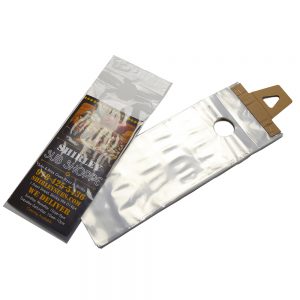
Electrically Conductive
Carbon-impregnated polyethylene bags providing exterior protection from static charges.
EVA
Ethylene Vinyl Acetate. Additive that strengthens and improves seal-ability. Appropriate for use in cold-temperature applications.
Faraday Cage
Provides both interior and exterior protection from static and other charges.
Flap Lock
Bag has lip folded back with side seals. Commonly known as a sandwich bag.
Flat Bags
Two-dimensional bag (width x length) with bottom or side seals. View Flat Poly bags.
Flexographic Print
Print that is solid colored - also known as line art. Each color requires a separate plate to print a solid color.
Fractional Melt
A resin additive used to increase the tensile strength, impact strength, abrasion resistance, and tear properties of poly bags and films.
Gauge
The thickness of material. The higher the gauge, the thicker the material.
GMO
GMO, or Genetically Modified Organism, is an organism whose genetic material has been altered using genetic engineering techniques. DNA molecules from different sources are combined into one molecule to create a new set of genes. This DNA is then transferred into an organism, which creates a protein. The protein material is harvested and converted into a material that is used as an alternative to plastic.
Glue Strip
A line of adhesive added to the bag to make it self-sealing...can be permanent or resealable
Grommet
A hang hole reinforced with a metal ring to help keep the bag from tearing
Gusseted Bags
Flat style bag with both sides or bottom tucked in to form gussets. Designated with three dimensions; Side Gusset (width x depth x length) or Bottom Gusset (width x length + gusset). View Gusseted Poly bags.
Hang Hole
A hole is added to the bag, usually near the top, allowing it to hang on a hook or have a tie inserted.
Header Bags
Side-weld bag with continuous seal along top, 2"-3" below fold. Bag is loaded and sealed from the bottom and typically has a hang hole.
High Density Polyethylene
Thinner, yet stronger than low density polyethylene. Moisture and vapor barrier, non-porous.
Hot Stamp Printing
Thermal bonding processes that results in the permanent adhesion of the print to the bag.
HDPE
High Density Poly Ethylene. This plastic film is most familiar for its use in standard retail store check-out bags
Linear Low Density Polyethylene
Stronger than low density. Resistant to punctures and tears, non-porous, and stretchable.
Lip
One side of the bag is longer than the other; allows bag to open easily.
Low Density Polyethylene
Porous and somewhat stretchable. Good clarity.
Machine Finished (MF)
A process of mechanically polishing paper between cylinders.
Machine Glazed (MG)
Usually on kraft paper, it’s smoother than machine finished.
Metallocene
Thinner and stronger than low density polyethylene. Puncture resistant.
Mil
Thickness of material. The higher the mil, the stronger the material. (1/1000 inch = 1 mil)
Natural Kraft
Unbleached paper in its natural form - brown in color.
OK Compost and DIN CERTCO EN 13432 Certifications
These two types of compost certifications are standard in Europe and are very similar to ASTM D6400 and D6868. They test to ensure that at least 90% of the organic material is converted into carbon dioxide. Similar to ASTM D6400, these testing specifications require that no more than 10% residue remains after three months and the resultant compost does not negatively affect plant growth. Although these certifications are the standard in Europe and other regions of the world, we recommend attaining BPI certification if you are using compostable products in the U.S.
Organic
Natural products that have been grown without the use of conventional pesticides and artificial fertilizers, free from contamination by human or industrial waste, and processed without ionizing radiation or food additives. Producers must be certified by an independent third-party certifying agency in order to use the USDA Organic label.
Oxo-Degradable
Often mistakenly called Oxo-Biodegradable, it is a plastic made from fossil fuels that has been treated with an additive that allows it to disintegrate over time through interaction with microbes. The chemical structure of the plastic is broken down with the help of oxygen and heat or sunlight, and then the smaller particles are utilized by micro-organisms as food. They do not pass ASTM 6400 regulations, however, because they do not degrade as quickly as the definition requires. They compost well and are safe for landfills.
Perforation
A line of small holes placed on a bag to make it easier to tear off or open...can also be used to make a tamper-evident bag
PLA
A type of bioplastic (also known as organic plastic). Polylactic acid or polylactide (PLA) is a form of plastic derived from corn or sugar cane. Starches from the corn and sugar cane are converted into carbon and other elements that are used to make the plastic polylactide.
Plant Starch Cutlery
Made from a type of bioplastic (also known as organic plastic), plant starch material is a biodegradable, thermoplastic resin. It is composed of starch combined with several other biodegradable materials. The cornstarch is modified in order to obtain heat-resistant properties, making the plant starch material one of the few bioplastics capable of withstanding high temperatures.
Adding another sheet of plastic to the bag, usually sealed on three sides, to provide additional, separate storage
Polypropylene
Stronger and more rigid than polyethylene. Preserves freshness with vapor and moisture barriers. Non-porous and excellent clarity. Ability to withstand high temperatures.
Process Print
Colors are reproduced by printing overlapping dots of cyan, magenta, yellow, and black (CMYK) inks to simulate a large number of different colors.
Random Print
A repeating print that appears in full on a bag at least once. A partial print may be visible on either side of the full print.
Reclosable Bags
Seal-top reclosable and reusable bags can be made with or without a tamper-evident adhesive seal. Also includes zipper and slider zipper bags. View Reclosable Poly bags.
Recyclable
A product or package that can be collected separated or otherwise recovered from the solid waste stream for reuse. The term may also be applied to the manufacture or assembly of another package or product through an established recycling program. Claims of recyclability should be qualified to the extent necessary to avoid consumer deception about any limited availability of recycling programs and collection sites.
Registered Print
The print shows up in the same spot on every bag in a production run.
Renewable Resource
A natural resource that can be replenished by natural processes at a rate comparable or faster than its rate of consumption by humans or other users. Renewable resources may also mean commodities such as wood, paper, and leather.
Side Gusset
A side gusset is formed by pushing the side edges of a flat poly bag into the bag interior, making accordion type folds or pleats along both sides of the bag. Side gusset bags are always bottom sealed. The size of the side gusset is measured across the open or unfolded dimension. Plastic bags constructed in this manner conform well to box-like shapes
Side Weld
Bags are sealed on the side. No bottom seal.
Slip
Additive that helps prevent bags from sticking to each other and promotes easy insertion of packaged goods.
SOS
Self-opening satchel.
Star Seal
Strongest bottom seal for liners that combines four sections in a star design. Seal maximizes carrying capacity.
Static Shielding
Four layer construction providing Faraday Cage protection. Offers greater protection than anti-static.
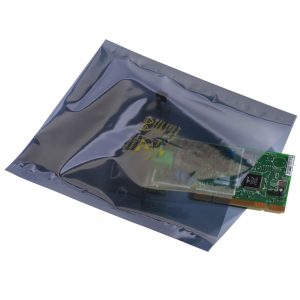
Tamper-Evident Zipper Lock Bags
Many zipper lock bag users (e.g. retail goods, food products) want to ensure that only their consumer utilizes the resealable zipper in the packaging. One way to accomplish this is to use a tamper-resistant zipper lock bag, which is basically a bottom-fill zipper lock bag that is pre-sealed above the zipper. A perforation in the plastic above the zipper allows the consumer to tear away the seal and access the zipper and the bag contents. Another type of tamper-evident zipper lock bag has a zipper that will not open once it has been closed except by destroying the bag itself.
Tensile Strength
The force required to break through film and bags, or snap rope, cable ties, and wire by pulling on opposite ends. Determined by material thickness and width.
Tubular Bags
Bags with no side seals or slit seals that are usually bottom sealed and have a tail.
UVI
Ultra Violet Inhibitor. Additive diminishes the effect of sunlight breaking up the film and extends film life in sunlight conditions.
Vent Hole
A small hole is added to the bag to allow air and moisture to pass through the bag
Wicketed Bags
Tear-off bags held in place by a metal wicket on the lip of the bag. View Wicketed Poly bags.
Write-on® Area
A white area imprinted on the bag allowing it to be written on
Zipper Lock Bags
Plastic bags can be made with narrow interlocking tracks, made from the same plastic material, that are sealed into the poly bag near the open end across the width. These are called zipper bags, zip lock bags or reclosables. Typically, the user places an item in the bag and then pinches one end of the track near the seal at the side and slides their fingers across the width of the bag, forcing the poly zipper tracks to merge and lock together. Most zipper lock bags can be opened and resealed a number of times.

